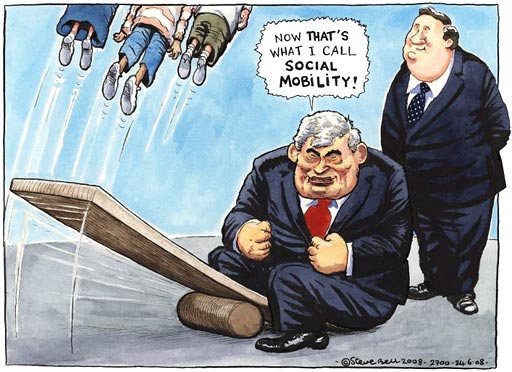 |
| Cartoon by Steve Bell, 2008 |
In 1848, Horace Mann, arguably
the grandfather of the American public school system, said, “Education then, beyond all other devices of
human origin, is a great equalizer of the conditions of men—the balance wheel
of the social machinery….it prevents being poor.” (Martinez-Blanco, Waldo, 2007). Those who give credence to this idea assume that, “By
providing a level playing field where the low and the mighty compete on an
equal basis, schooling renders social inequality superfluous” (Macleod,
2009). In academia, this
disposition is sometimes called The Achievement Ideology (Macleod, 2009). However,
data reveals a different story than the Achievement ideology would have us
believe. When we look at statistics
comparing students from low socio-economic status (SES) backgrounds to their
counterparts from high SES backgrounds, ‘the great equalizer’ (e.g. education) does
not seem to be doing much equalizing and the ‘level playing field’ isn’t so
level. Indeed, a Brookings
Institute funded research project (Future of Children Research) executive
summary of social mobility outcomes in the US found that, “Mobility in the U.S. is not as high as it is in other
rich countries” (2006). Specifically, Harvard Professor and researcher John
Diamond notes that students from the lowest SES quartile have college enrollment
rates of 54%, compared to students from the highest SES quartile with 94%. Additionally, a student with high math
test scores from a low SES household is less likely to earn a bachelors degree than
someone from a high SES household with low test scores (Diamond, 2012). And since educational achievement is a
strong indicator of occupational status and achievement (Collins, 1971) it
would seem that the deck is stacked against those from low SES backgrounds. For students from low SES households,
in other words, social-mobility is, by and large, a Sisyphean task, and social
reproduction is too often a foregone conclusion.
In this paper, I focus on
social-reproduction/mobility as it relates to the urban school contexts. To begin, I paint a picture of the
landscape of urban schooling; then I summarize critical theories of stratification
and relate them to social-reproduction/mobility in urban schools; lastly, I end
by briefly sharing my journey as a teacher in urban schools and how I observed stratification
theories personified in the people and schools where I worked.
No comments:
Post a Comment